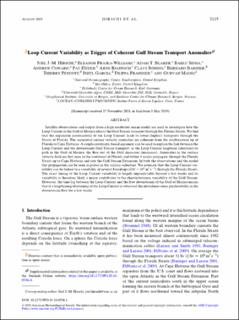| dc.contributor.author | Hirschi, Joël J.-M. | |
| dc.contributor.author | Frajka-Williams, Eleanor | |
| dc.contributor.author | Blaker, Adam T | |
| dc.contributor.author | Sinha, Bablu | |
| dc.contributor.author | Coward, Andrew | |
| dc.contributor.author | Hyder, Pat | |
| dc.contributor.author | Biastoch, Arne | |
| dc.contributor.author | Böning, Claus | |
| dc.contributor.author | Barnier, Bernard | |
| dc.contributor.author | Penduff, Thierry | |
| dc.contributor.author | Garcia, Ixetl | |
| dc.contributor.author | Fransner, Filippa | |
| dc.contributor.author | Madec, Gurvan | |
| dc.date.accessioned | 2021-01-04T13:38:55Z | |
| dc.date.available | 2021-01-04T13:38:55Z | |
| dc.date.created | 2020-03-02T14:20:35Z | |
| dc.date.issued | 2019 | |
| dc.Published | Journal of Physical Oceanography. 2019, 49 (8), 2115-2132. | en_US |
| dc.identifier.issn | 0022-3670 | |
| dc.identifier.uri | https://hdl.handle.net/11250/2721304 | |
| dc.description.abstract | Satellite observations and output from a high-resolution ocean model are used to investigate how the Loop Current in the Gulf of Mexico affects the Gulf Stream transport through the Florida Straits. We find that the expansion (contraction) of the Loop Current leads to lower (higher) transports through the Straits of Florida. The associated surface velocity anomalies are coherent from the southwestern tip of Florida to Cape Hatteras. A simple continuity-based argument can be used to explain the link between the Loop Current and the downstream Gulf Stream transport: as the Loop Current lengthens (shortens) its path in the Gulf of Mexico, the flow out of the Gulf decreases (increases). Anomalies in the surface velocity field are first seen to the southwest of Florida and within 4 weeks propagate through the Florida Straits up to Cape Hatteras and into the Gulf Stream Extension. In both the observations and the model this propagation can be seen as pulses in the surface velocities. We estimate that the Loop Current variability can be linked to a variability of several Sverdrups (1Sv = 106 m3 s−1) through the Florida Straits. The exact timing of the Loop Current variability is largely unpredictable beyond a few weeks and its variability is therefore likely a major contributor to the chaotic/intrinsic variability of the Gulf Stream. However, the time lag between the Loop Current and the flow downstream of the Gulf of Mexico means that if a lengthening/shortening of the Loop Current is observed this introduces some predictability in the downstream flow for a few weeks. | en_US |
| dc.language.iso | eng | en_US |
| dc.publisher | AMS | en_US |
| dc.title | Loop current variability as trigger of coherent gulf stream transport anomalies | en_US |
| dc.type | Journal article | en_US |
| dc.type | Peer reviewed | en_US |
| dc.description.version | publishedVersion | en_US |
| dc.rights.holder | Copyright 2019 American Meteorological Society | en_US |
| cristin.ispublished | true | |
| cristin.fulltext | original | |
| cristin.qualitycode | 2 | |
| dc.identifier.doi | 10.1175/JPO-D-18-0236.1 | |
| dc.identifier.cristin | 1798964 | |
| dc.source.journal | Journal of Physical Oceanography | en_US |
| dc.source.40 | 49 | en_US |
| dc.source.14 | 8 | en_US |
| dc.source.pagenumber | 2115-2132 | en_US |
